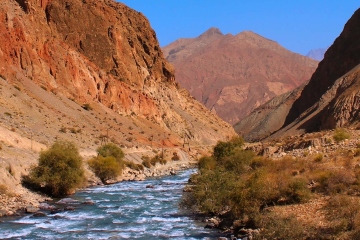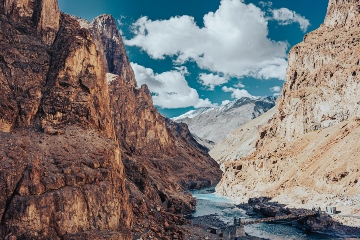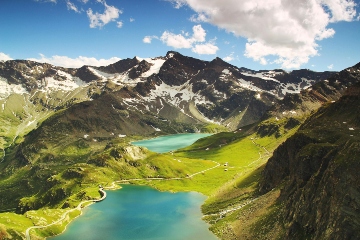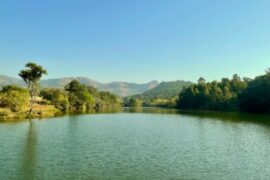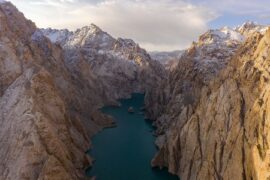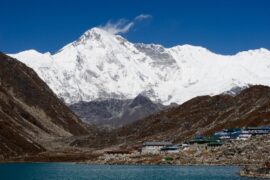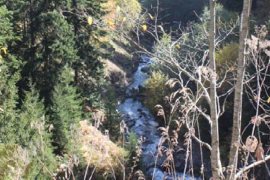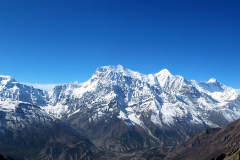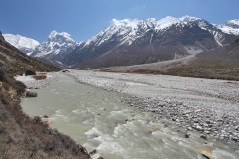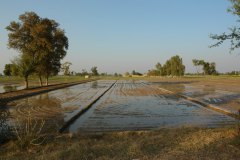Desafío
Las montañas actúan como «torres de agua» capaces de almacenar y liberan agua a los piedemontes y valles donde se concentran los oasis de riego y ambientales. En comparación con las generadas en los piedemontes y valles, las altas montañas generan una escorrentía mayor y continua en el tiempo, debido a las precipitaciones orográficas y a la fusión y deshielo de los mantos nivales y glaciares. Debido a su capacidad de amortiguación y liberación lenta de agua durante los periodo de alta temperaturas, las montañas proporcionan un suministro de agua relativamente constante a los piedemontes y valles (Immerzeel et al., 2019; Viviroli et al., 2003). Esta agua se utiliza para el sostenimiento de ecosistemas naturales y de oasis de riego extremadamente fértiles (Contreras et al., 2011; Biemans et al., 2019), para fines domésticos e industriales, y para generar la mayor parte de la energía hidroeléctrica disponible (Gernaat et al., 2017; Hoes et al., 2017)
Las cadenas montañosas son sistemas muy vulnerables al cambio climático, y más aún cuánto mayor es la altitud, ya que la temperatura aumenta más rápidamente en estas regiones que en las áreas circundantes (Pepin et al., 2015), afectando de manera muy incisiva al almacenamiento de agua en forma de hielo y nieve (Kraaijenbrink et al., 2017). Esto conduce a cambios en los regímenes hidrológicos con cambios estacionales y una respuesta hidrológica más rápida (Huss y Hock, 2018; Lutz et al., 2014). Por otro lado, la presión sobre los recursos hídricos de alta montaña aumentará con la creciente demanda de agua en los piedemontes y valles dependientes. El cambio climático también conduce a un aumento del clima extremo en las montañas, que ya se caracterizan por el clima extremo frecuente en la actualidad. Esto aumenta fuertemente el riesgo de inundaciones y deslizamientos de tierra.
En resumen, las regiones montañosas y sus áreas de piedemonte y valles circundantes están sujetas a fuertes cambios futuros, que deben tenerse en cuenta en la adaptación al cambio climático y las decisiones de inversión.
Enfoque FutureWater
FutureWater tiene una experiencia única en hidrología de montaña líder en el mundo. Esta experiencia se utiliza en investigación y consultoría, donde implementamos con frecuencia nuestro modelo SPHY, que tiene fortalezas específicas para simular la hidrología de alta montaña en condiciones de escasez de datos. Desarrollamos proyecciones de la disponibilidad futura de agua, brindamos información detallada sobre los cambios esperados en la estacionalidad del suministro de agua y podemos evaluar cómo estos coinciden con los cambios futuros en la demanda de agua. Para el sector hidroeléctrico, proporcionamos proyecciones detalladas de flujo futuro y generación de energía para ayudar a las decisiones de inversión, y brindamos evaluaciones de riesgo climático en regiones montañosas para una variedad de sectores. Brindamos investigación y asesoramiento a escalas que van desde cuencas individuales hasta grandes cuencas fluviales. Nuestras evaluaciones no se detienen en la transición de las tierras altas a las tierras bajas, pero establecemos el vínculo entre aguas arriba y aguas abajo para brindar asesoramiento sobre la gestión integrada de los recursos hídricos y la consideración del nexo agua-alimentos-energía.
Proyectos relacionados
-
Water Supply-Demand Gap analysis for Rogun Dam
The Rogun Hydropower Plant Project (HPP) is a large project (3,780MW) under construction located on the Vakhsh River located about 110 km East-Northeast of Dushanbe, the capital of Tajikistan. It is a Project that will have a large reservoir capable of providing seasonal regulation. It will supply firm energy during...
-
Springshed Management in the Indian Himalayas
Springs in the Hindu Kush Himalaya (HKH) region are essential for water security, agriculture, economic activities, ecosystem services, biodiversity, and cultural heritage. They sustain nearly 240 million people, including 50 million in India who depend directly on these springs for their water needs. However, almost half of the perennial springs...
-
Megasequías en las torres de agua de Europa – de comprender los procesos a estrategias de gestión y adaptación
Las megasequías son fenómenos raros y poco conocidos. Se definen como periodos de sequía excepcionalmente severos, carácter multianual y duración prolongada (>5 años), y que generan impactos extremos que afectan a grandes extensiones y diferentes sectores de la economía y del medio ambiente (Cook et al. (2022), Nat Rev Earth...
-
Integrated Water Resources Management in Tajikistan
Given the abundant freshwater resources in Tajikistan, water plays a crucial role in the country's socioeconomic development. However, the rising population, economic growth, and the growing impacts of climate change pose significant challenges to ensure water availability and accessibility. This project aims to address the aforementioned information gap by improving...
-
GLOW: Global Water Availability Forecasting Service to Support Water Security
The GLOW project aims to pilot an operational service that provides timely and easy access to current and forecasted water availability and demand across the entire Maputo River and the Black Umbeluzi River Basins.
-
WE-ACT: Water Efficient Allocation in a Central Asian Transboundary River Basin
El objetivo general del proyecto WE-ACT es demostrar un sistema de apoyo a la toma de decisiones (DSS) para la asignación de agua en un río transfronterizo de Asia Central, con el fin de aumentar los beneficios compartidos y fomentar la adaptación de la gestión y planificación de los recursos...
-
Climate Risk and Adaptation Assessment for Hydropower Project in Nepal
Climate risk and adaptation (CRA) assessment is required for the 635 MW Dudhkoshi hydroelectric project (DKSHEP) to ensure the project addresses climate change mitigation and adaptation in accordance with ADB’s requirements. The initial Climate Risk Assessment (CRA) by FutureWater in 2021 suggested the project is likely to be affected by...
-
Climate Risk and Adaptation Assessment for Nepal’s Power Sector
Nepal’s power sector predominantly relies on hydropower generation. Hydropower is vulnerable to climate change and natural disasters caused by climate change. An understanding of the future impact of climate change on hydropower assets and their performance is important for the successful implementation of hydropower projects. Climate risk and adaptation (CRA)...
-
Development of a Glacio-Hydrological Model and IWRM Plan for the Uttarakhand subbasin in India
The Swiss Agency for Development and Cooperation’s (SDCs) Global Programme Climate Change and Environment (GP CCE) India is supporting the operationalization of climate change adaptation actions in the mountain states of Uttarakhand, Sikkim and Himachal Pradesh through the phase two of the “Strengthening State Strategies for Climate Action” (3SCA) project...
-
Hydrological Assessment for Hydropower in the Lukhra River
The objective was to develop a hydrological assessment for a planned run-of-river hydropower plant in the Lukhra river basin in Georgia. There is no observed river discharge data available. Hence, the assessment was developed based on hydrological simulations of the basin using the SPHY model (Terink et al., 2015) and...
-
Glacio-hydrological Assessment for Hydropower in the Nakhra River
The objective was to develop a glacio-hydrological assessment for planned run-of-river hydropower plant locations in the Nakhraa river basin in Georgia. The availability of observed river flow data is limited. Hence the assessment was developed based on hydrological simulations of the basin using the SPHY model (Terink et al., 2015)....
-
Thought Leader Convening on Water Towers
Scientists from around the world have assessed the planet’s 78 mountain glacier–based water systems and, for the first time, ranked them in order of their importance to adjacent lowland communities, as well as their vulnerability to future environmental and socioeconomic changes. These systems, known as mountain water towers, store and...
-
Pan-TPE: Changes in the Pan-Third Pole Water Tower
The proposed research targets changes in climate, water supply and demand, and suitable adaptation measures for green development of the Silk Road Economic Belt (SREB) in the river basins crossed by the SREB transect. Given the strong role of large scale hydrology in the proposed research activities, the spatial domain...
-
Evaluación del riesgo climático usando el Marco del Árbol de Decisión para dos proyectos hídricos en Kenia y Nepal
La novedosa metodología del Marco del Árbol de Decisión (DTF) del Banco Mundial se emplea para evaluar los riesgos climáticos versus otros riesgos no climáticos asociados a dos inversiones planificadas: (1) la infraestructura de protección contra inundaciones y expansión de tierras de cultivo irrigadas en el río Nzoia (Kenia); y...
-
Hydropower Development Assessment for the Tamakoshi River Basin
The overall objective of this project is to improve the understanding of the expected impacts of climate change on water availability in the context of potential hydropower development in the Tamakoshi River Basin. Specifically, the project aims to (i) Understand the current baseline hydrological regime of the Tamakoshi River Basin,...
-
Review Climate Change Hindu-Kush-Himalaya
FutureWater provided a comprehensive review study on climate change and the impacts on cryosphere, hydrological regimes and glacier lakes in the Indus, Ganges, and Brahmaputra river basins. This review study was done in the context of future hydropower development in the region.
-
HI-AWARE: Himalayan Adaptation, Water and Resilience
HI-AWARE aims to contribute to enhanced adaptive capacities and climate resilience of the poor and vulnerable women, men, and children living in the mountains and flood plains of the Indus, Ganges, and Brahmaputra river basins. Research, including modeling, scoping studies, action research, and randomized control trials, is conducted at 12...
-
Central Asia Regional Risk Assessment for Water Related Energy Sector Impacts
The objective of this study was to support the “Central Asia Regional Energy Sector Vulnerability Study” led by Industrial Economics (IEc) and funded by the World Bank, by carrying out an expanded risk assessment for water availability and water related energy sector impacts in Central Asia. The work built on...
-
Gridded Meteorological Datasets and Hydrological Modelling in the Upper Indus Basin
Understanding of the hydrological regimes in the mountainous Upper Indus basin (UIB) is essential for water resources management in the region. High-resolution gridded meteorological datasets, which capture the spatial variability of precipitation, are critical for modelling the hydrology of high-mountain regions. Improvements to existing gridded datasets using high-elevation station data...
-
Monitoring of Glacier, Climate and Runoff in the Hindu – Kush Himalayan Mountains
For this project a review was conducted of current state of knowledge in (i) climate change datasets and downscaling used for glacier and high mountain modelling, (ii) glacier and snow contribution to river runoff in the Hindu – Kush Himalayan (HKH) region, (iii) hydrological modelling studies used for glacier and...

